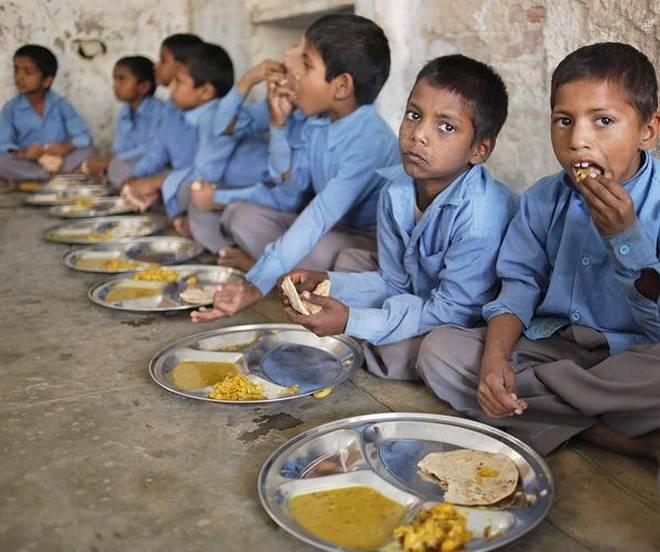Mid-Day Meal Programme Linked to Improved Growth in Children of Beneficiaries, Says Study

Representational Image. Image Courtesy: The Hindu
New Delhi: Women who received free meals in primary school have children with improved linear growth, according to a new study by researchers at the International Food Policy Research Institute (IFPRI) that was published in the science journal Nature Communications.
India is home to the highest number of undernourished children and the largest school feeding programme in the world—the Mid-Day Meal (MDM) scheme. However, the long-term benefits of the programme on nutrition are mostly unknown. As school feeding programmes target children outside the highest return “first 1000-days” window spanning from conception until a child’s second birthday, they have not been a focal point in the global agenda to address stunting.
In a statement released by IFPRI, Harold Alderman, co-author of the study, said: “Findings from previous evaluations of India’s MDM scheme have shown a positive association with beneficiaries’ school attendance, learning achievement, hunger and protein-energy malnutrition, and resilience to health shocks such as drought—all of which may have carryover benefits to children born to mothers who participated in the programme.”
The authors used nationally representative data on mothers and their children spanning from 1993 to 2016 to assess whether MDM supports inter-generational improvements in child linear growth. Further, the study also suggests a potential pathway through which school feeding programmes may have inter-generational effects on child nutrition outcomes.
The study found that investments made in school meals in previous decades were associated with improvements in future child linear growth. “Our findings suggest that intervening during the primary school years can make important contributions to reducing future child stunting, particularly given the cumulative exposure that is possible through school feeding programmes,” said the study’s co-author Suman Chakrabarti.
The study pointed out that in spite of initiatives by the government, under-nutrition levels in India are still among the highest in the world. It said that significant progress occurred, for the first time, between the third and fourth rounds of the National Family Health Survey (NFHS), that is, between 2005-6 and 2015-16. “However,” it stated, “partial findings of the fifth round, released a few months ago, suggest no further progress between 2015-16 and 2019-20 – just before the Covid-19 crisis.”
“As it happens, this period began with the demonetisation blunder and severe budget cuts for child nutrition programmes. Based on the complete fourth-round NFHS findings, the proportion of underweight children was as high as 36% in India in 2015-16, against 22% in Bangladesh (2018) and 27% in Nepal (2016) based on comparable surveys. According to the World Development Indicators, only two or three countries, such as Niger and Yemen, have a higher proportion of underweight children,” the report added.
Activists and civil society organisations reminded the Union government and state governments of the importance of the MDM scheme, especially during the ongoing pandemic. In its order dated March 27, 2020, the Supreme Court of India expressed concern over large-scale malnourishment resulting from non-supply of nutritional food to children as well as lactating and nursing mothers with the schools and Anganwadis shutting down during the lockdown. It called upon the state governments to ensure that such schemes are not adversely affected.
According to the Hunger Watch Survey conducted in 11 states by the Right to Food Campaign in September, 2020, only 57% households with school going children said their children received mid-day meals or alternative (dry rations/cash) in September-October, 2020. The Campaign had urged the government to ensure that nutritious hot cooked meals, including eggs, through anganwadi centres and school midday meals to be distributed while following all safety guidelines related to distancing, sanitisation, etc.
However, mid-day meals were still not provided to school-going children across all the states. During the lockdown, there was a severe disruption of public services, including nutrition-related services: midday meals, in particular, were discontinued as anganwadis and schools were closed in most states.
Despite all of this, in the Union Budget for 2021-22, the allocation for the National Programme of Mid Day Meal in Schools under the Ministry of Education, was increased Rs 11,000 crore in the budget estimate for 2020-21 to Rs 11,500. According to noted economist Jean Drèze, if inflation is taken into account, one would see that between the years 2014 (the year the current Bharatiya Janata Party regime came to power) and 2021, the allocation for the MDM scheme has been reduced by 32.3%.
The MDM scheme is mandated by the Supreme Court of India as a social protection program addressing food insecurity. The IFPRI study said, “The social protection role of addressing hunger and food insecurity may be a justification by itself for school-based transfers in many settings. However, evidence such as presented here depict these programs as contributing to both food security and to improved outcomes in the next generation, thus contribute to the policy framework for school-based interventions.”
While studies like this emphasise the importance of strengthening the MDM scheme, the trend in budget allocation for the scheme shows that the Union government is apathetic toward growing malnutrition among children in the country, at a time when India should be actively taking giant measures to improve the situation.
Get the latest reports & analysis with people's perspective on Protests, movements & deep analytical videos, discussions of the current affairs in your Telegram app. Subscribe to NewsClick's Telegram channel & get Real-Time updates on stories, as they get published on our website.
























